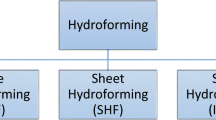Abstract
Rough surface profiles are specified for metal surfaces so that corrosion preventative coatings adhere well and provide long-term protection. Simple stylus scans and replica tape are widely used in industry to characterize surfaces and control the quality of surface preparation. Unfortunately, a scientific, quantitative connection between adhesion and surface profile parameters remains unclear. Stereo-pair images from scanning electron microscopy, SEM, were used to digitally reconstruct and then characterize 3D surfaces, which is a technique that seems previously unreported in coatings applications. SEM results were consistent with those from a stylus profilometer, but the data from a surface scan are much more numerous than from a line scan, and SEM can provide very high magnifications. 3D surfaces at high magnification gave larger values for the increase in area developed by the abrasive blasting than were determined at lower magnifications and by the stylus profilometer. Nevertheless, both techniques showed that the surface roughness height and ramification was far less than might be expected from illustrations in the existing literature on coatings’ adhesion. Quantified characterization, with details shown at high magnification, may provide scientific insight into how the various features of a roughened surface enhance the adhesion of protective coatings.





Similar content being viewed by others
References
ASTM D7127-17, Standard Test Method for Measurement of Surface Roughness of Abrasive Blast Cleaned Metal Surfaces Using a Portable Stylus Instrument. ASTM International, West Conshohocken, PA, United States
ASTM D4417-14, Standard Test Methods for Field Measurement of Surface Profile of Blast Cleaned Steel. ASTM International, West Conshohocken, PA, United States
Leach, R, “Surface Topography Measurement Instrumentation.” In: Leach, R (ed.) Fundamental Principles of Engineering Nanometrology, Chapter 6, 2nd ed., pp. 133–204. Elsevier, Amsterdam (2014)
Beamish, D, “Replica Tape: Unlocking Hidden Information.” J. Protect. Coat. Linings, 32 (6) 1–6 (2015)
Roper, HJ, Weaver, R, Brandon, JH, “The Effect of Peak Count on Surface Roughness on Coating Performance.” J. Protect. Coat. Linings, 22 (6) 52–64 (2005)
Tordonato, D, “Adhesion Testing: How Much is Sufficient?” J. Protect. Coat. Linings, 35 (11) 11–16 (2018)
Momber, AW, Koller, S, Dittmers, HJ, “Effects of Surface Preparation Methods on Adhesion of Organic Coatings to Steel Substrates.” J. Protect. Coat. Linings, 21 (11) 44–50 (2004)
Dickie, RA, “Paint Adhesion, Corrosion Protection, and Interfacial Chemistry.” Prog. Org. Coat., 25 3–22 (1994)
Keane, JD, Bruno, JA, Weaver, REF, “Surface Profile for Anti-Corrosion Paints.” SSPC Report on Research Project no. 71-14, Carnegie-Mellon Institute of Research, October 11 (1976)
Cuenat, A, Leach, R, “Scanning Probe and Particle Beam Microscopy.” In: Leach, R (ed.) Fundamental Principles of Engineering Nanometrology, Chapter 7, 2nd ed., pp. 205–239. Elsevier, Amsterdam (2014)
ISO 4287 Geometrical Product Specifications (GPS)—Surface Texture: Profile Method—Terms, Definitions and Surface Texture Parameters (1997)
ASME B46.1-2009, Surface Texture (Surface Roughness, Waviness, and Lay). American Society of Mechanical Engineers, New York, NY (2010)
Peitgen, H-O, Saupe, D (eds.), The Science of Fractal Images. Springer, New York (1988)
Amada, S, Satoh, A, “Fractal Analysis of Surfaces Roughened by Grit Blasting.” J. Adhes. Sci. Technol., 14 (1) 27–41 (2000)
Mannelqvist, A, Ring Groth, M, “Comparison of Fractal Analyses Methods and Fractal Dimension for Pre-Treated Stainless Steel Surfaces and the Correlation to Adhesive Joint Strength.” Appl. Phys. A, 73 347–355 (2001)
Bouchard, E, Lapasset, G, Planès, J, “Fractal Dimension of Fractured Surfaces: A Universal Value?” Europhys. Lett., 13 (1) 73–79 (1990)
Persson, BNJ, “On the Fractal Dimension of Rough Surfaces.” Tribol. Lett. B, 54 99–106 (2014)
SSPC-SP 10/NACE No. 2, Near-White Metal Blast Cleaning, 2006, The Society for Protective Coatings, Pittsburgh, PA 15222, United States
Budinski, KG, Chin, H, “Surface Alteration in Abrasive Blasting.” In: Ludema, KC (ed.) Wear of Materials-1983, pp. 311–318. American Society of Mechanical Engineers, New York (1983)
Pan, B, “Digital Image Correlation for Surface Deformation Measurement: Historical Developments, Recent Advances and Future Goals.” Meas. Sci. Technol., 29 082001 (2018)
Tafti, AP, Kirkpatrick, AB, Alavic, Z, Owen, HA, Yua, Z, “Recent Advances in 3D SEM Surface Reconstruction.” Micron, 78 54–66 (2015)
Danzl, R, Scherer, S, Kolednik, O, “Automatic Registration of Corresponding Fracture Surfaces.” In: Proceedings of the 12th International Metallographic-Tagung, Leoben, pp. 127–134 (2006)
Podsiadlo, P, Stachowiak, GW, “Characterization of Surface Topography of Wear Particles by SEM Stereoscopy.” Wear, 206 39–52 (1997)
Abbott, S, Adhesion Science Principles and Practice. Destech Publications, Lancaster, PA (2015)
Richardson, LF, “The Problem of Contiguity: An Appendix of Statistics of Deadly Quarrels.” Gen. Syst. Yearb., 6 139–187 (1961)
Losa, G, Ristanović, D, Ristanović, D, Zaletel, I, Beltraminelli, S, “From Fractal Geometry to Fractal Analysis.” Appl. Math., 7 346–354 (2016)
Hurst, HE, “A Suggested Statistical Model of Some Time Series Which Occur in Nature.” Nature, 180 494 (1957)
Gneiting, T, Schlather, M, “Stochastic Models Which Separate Fractal Dimension and Hurst Effect.” SIAM Rev., 46 (2) 269–282 (2004)
Clarke, KC, “Computation of the Fractal Dimension of Topographic Surfaces Using the Triangular Prism Surface Area Method.” Comput. Geosci., 12 (5) 713–722 (1986)
Leach, R, Evans, C, He, L, Davies, A, Duparré, A, Henning, A, Jones, CW, O’Connor, D, “Open Questions in Surface Topography Measurement: A Roadmap.” Surf. Topogr. Metrol. Prop., 3 013001 (2015)
Griffith, AA, “The Phenomena of Rupture and Flow in Solids.” Philos. Trans. R. Soc. A, 221 163–198 (1921)
Acknowledgments
One of the authors (SGC) would like to thank his colleagues and contacts in industry, especially at Northwest Pipe and the Bureau of Reclamation, for many discussions and helping with materials and samples. This material is based on the work supported by the National Science Foundation under Grant No. 0619098.
Author information
Authors and Affiliations
Corresponding author
Additional information
Publisher's Note
Springer Nature remains neutral with regard to jurisdictional claims in published maps and institutional affiliations.
Rights and permissions
About this article
Cite this article
Croll, S.G., Payne, S.A. Quantifying abrasive-blasted surface roughness profiles using scanning electron microscopy. J Coat Technol Res 17, 1231–1242 (2020). https://doi.org/10.1007/s11998-020-00342-3
Published:
Issue Date:
DOI: https://doi.org/10.1007/s11998-020-00342-3




